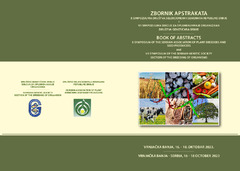Приказ основних података о документу
Uvidi u nasledne mehanizme otpornosti suncokreta na ugljenastu trulež: genetski faktori
Insights into the inheritance mechanisms of sunflower resistance to charcoal rot: unraveling the genetic factors
| dc.creator | Ćuk, Nemanja | |
| dc.creator | Cvejić, Sandra | |
| dc.creator | Mladenov, Velimir | |
| dc.creator | Miladinović, Dragana | |
| dc.creator | Jocić, Siniša | |
| dc.creator | Krstić, Miloš | |
| dc.creator | Babec, Brankica | |
| dc.creator | Jocković, Milan | |
| dc.creator | Dedić, Boško | |
| dc.date.accessioned | 2023-11-11T20:00:35Z | |
| dc.date.available | 2023-11-11T20:00:35Z | |
| dc.date.issued | 2023 | |
| dc.identifier.isbn | 978-86-87109-17-9 | |
| dc.identifier.uri | http://fiver.ifvcns.rs/handle/123456789/3997 | |
| dc.description.abstract | Ugljenasta trulež prouzrokovana gljivom Macrophomina phaseolina (Tassi) Goid, predstavlja jednu od ekonomski značajnih bolesti suncokreta u svetu, posebno u suvim i toplim klimatskim regionima. Ovo istraživanje imalo je za cilj ispitivanje mehanizama nasleđivanja otpornosti na M. phaseolina analizom dve populacije suncokreta. Obe populacije su formirane ukrštanjem otpornih i osetljivih inbred linija. Osetljiva inbred linija, AB OR8, bila je zajednička za obe populacije, dok je otporni roditelj u prvoj populaciji bila inbred linija PB 21, a u drugoj populaciji inbred linija VL A8. Prva populacija obuhvatala je 200 genotipova, a druga po pulacija 190. Genotipovi su klasifikovani u četiri grupe prema nivou otpornosti, a odnos ovih grupa je upoređen sa teorijskim očekivanim odnosima. | sr |
| dc.description.abstract | Charcoal rot, caused by soil-borne fungus Macrophomina phaseolina (Tassi) Goid, stands out as a significant sunflower disease globally, particularly in arid and warm climatic regions, with notable economic implications. This study aimed to examine the inheritance mechanisms of resistance to M. phaseolina by investigating two sunflower populations. In this experiment, the progeny populations of F2 plants were examined. Both populations were formed through the strategic crossing of resistant and susceptible inbred lines. The susceptible inbred line AB OR 8, was common to both populations, while the resistant parent in the first population was inbred line PB 21, and in the second population inbred line VL A 8. The first population included 200 genotypes, and the second 190. Genotypes were classified in four groups according to resistance level and ratio of these groups was compared with theoretical expectations of progeny ratio. | sr |
| dc.language.iso | sr | sr |
| dc.publisher | Beograd : Društvo genetičara Srbije | sr |
| dc.publisher | Beograd : Društvo selekcionera i semenara Srbije | sr |
| dc.relation | info:eu-repo/grantAgreement/MESTD/inst-2020/200032/RS// | sr |
| dc.relation | info:eu-repo/grantAgreement/ScienceFundRS/Ideje/7732457/RS// | sr |
| dc.relation | info:eu-repo/grantAgreement/EC/HE/101059784/EU// | sr |
| dc.relation | Climate Crops - Centre of Excellence for Innovations in Breeding of Climate-Resilient Crops, Institute of Field and Vegetable Crops | |
| dc.rights | openAccess | sr |
| dc.rights.uri | https://creativecommons.org/licenses/by/4.0/ | |
| dc.source | Zbornik apstrakata, 10. Simpozijum Društva selekcionera i semenara Republike Srbije i 7. Simpozijum Sekcije za oplemenjivanje organizama Društva genetičara Srbije, Vrnjačka Banja, 16-18.10.2023. | sr |
| dc.subject | geni | sr |
| dc.subject | mikoze | sr |
| dc.subject | F2 populacija | sr |
| dc.subject | inbred linija | sr |
| dc.subject | genes | sr |
| dc.subject | fungus | sr |
| dc.subject | F2 populations | sr |
| dc.subject | inbred line | sr |
| dc.subject | Macrophomina phaseolina | sr |
| dc.title | Uvidi u nasledne mehanizme otpornosti suncokreta na ugljenastu trulež: genetski faktori | sr |
| dc.title | Insights into the inheritance mechanisms of sunflower resistance to charcoal rot: unraveling the genetic factors | sr |
| dc.type | conferenceObject | sr |
| dc.rights.license | BY | sr |
| dc.citation.epage | 72 | |
| dc.citation.spage | 71 | |
| dc.identifier.fulltext | http://fiver.ifvcns.rs/bitstream/id/9700/bitstream_9700.pdf | |
| dc.identifier.rcub | https://hdl.handle.net/21.15107/rcub_fiver_3997 | |
| dc.type.version | publishedVersion | sr |


